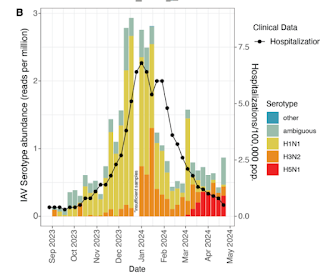#18,058
While it may seem that our present circumstances - where a virulent and deadly (primarily to birds) avian influenza virus has spread across the nation, spilling over into cats, dogs, livestock, and even humans - is unprecedented, just over 150 years ago North America was embroiled in a similar event; the Epizootic of 1872.
All of this occurred decades before the influenza virus was identified, and viable samples of the 1872 virus have never been found or analyzed, but there is fairly convincing evidence that an early avian influenza virus (subtype unknown) was involved.
In 2010 the NIH tag team flu experts David Morens and Jeffrey K. Taubenberger penned a fascinating account of the 1872 equine epizootic - an epidemic in horses that spread from Canada to Mexico in a matter of months - and brought transportation to a standstill in this country (see A New Look At The Panzootic Of 1872).
This report provides a tantalizing review of anecdotal reports of a concurrent epizootic affecting poultry, and even causing human illness across the nation.Morens and Taubenberger (2010) An avian outbreak associated with panzootic equine influenza in 1872: an early example of highly pathogenic avian influenza? Influenza and Other Respiratory Viruses 4(6), 373–377.
They wrote:
An explosive fatal epizootic in poultry, prairie chickens, turkeys, ducks, and geese occurred over much of the populated United States between November 15 and December 15, 1872. The epizootic progressed in temporal-geographic association with a well-reported panzootic of equine influenza, which had begun in or around Markham, Ontario, during the last few days of September 1872,1–4 at a time when human influenza had not been recently prevalent.
The equine epizootic spread rapidly into the United States along railroad lines, with separate simultaneous introductions into Michigan and upper New York State. It quickly spread over the entire United States to the Caribbean and Central America (Figure 1).
Horses, mules, and menagerie/circus zebras were involved, with “spill over” infections into dogs and cats.4Whether this was an avian flu that jumped to horses, or an equine flu that spilled over into poultry - or two separate events - may never be known. But Taubenberger and Morens wrote in their conclusion:
Numerous individual human cases and localized outbreaks throughout the United States, often associated with exposures to ill horses, were reported. The human disease, generally mild and uncomplicated, was popularly referred to as the “epizooty”, or “zooty”.4
Another microbial agent could have caused the avian outbreak; however, its strong temporal and geographic association with the equine panzootic, and its clinical and epidemiologic features, are most consistent with highly pathogenic avian influenza. The avian epizootic could thus have been an early instance of highly pathogenic avian influenza.
Taubenberger and Morens also noted anecdotal reports of similar illnesses in wild deer, and in pigs with exposure to stables with sick horses, although it is impossible to know whether the same virus was to blame.
Although the disease was rarely fatal in horses (1%-10%), it could be debilitating for weeks, and it sparked a nationwide transportation crisis at a time when `horse power' really referred to horses.
In November of 1872, during the height of the crisis in Boston, horse drawn fire engines were unable to quickly respond to a fire which began in the basement of a warehouse, and quickly spread, leading to the loss of hundreds of buildings (see the Dakota Digital Review The Great Boston Fire & Epizootic of 1872 in a matter of hours.
It is estimated 75% of the horses in North America were affected, leaving horse-drawn cable cars in San Francisco out of service, farmers unable to transport their harvests to market, the mail undelivered, and factories unable to ship or receive parts.
Newspapers tried to make light of the situation, coming up with disease names like `henfluenza' and `chickizooty', while the Pennsylvania Dutch dubbed it Pferdhühnkrankheit (“horse‐chicken‐disease”).
But as the disease spread from coast-to-coast (following the railroad lines) its economic impact was severe (see the Historical Society of Ottawa's account: The Great Epizootic).
And while seemingly related human flu infections that winter were characterized as `mild', major influenza epidemics were reported in both 1873 and 1874. Whether they were related to the virus of 1872 is unknown.
There have been other `equine influenza' outbreaks over the years, without apparent spillover into other species, giving credence to the idea that this event was an outlier, and likely due to an avian influenza virus.
Although it is assumed that the epizootic of 1872 spared cows and cattle, it is possible they were asymptomatically infected.
As we've discussed previously (see A Brief History Of Influenza A In Cattle/Ruminants), there is at least one mention in the literature of influenza in cattle going back to the late 1800s in Japan.
While there are certainly differences between the epizootic of 1872 and the epizootic of today, both suggest that novel influenza viruses can have an unexpectedly wide host range, including:
- Poultry and wild birds
- Livestock (horses, goats, pigs, and cattle)
- Wildlife (foxes, skunks, deer, marine mammals, etc.)
- Humans











